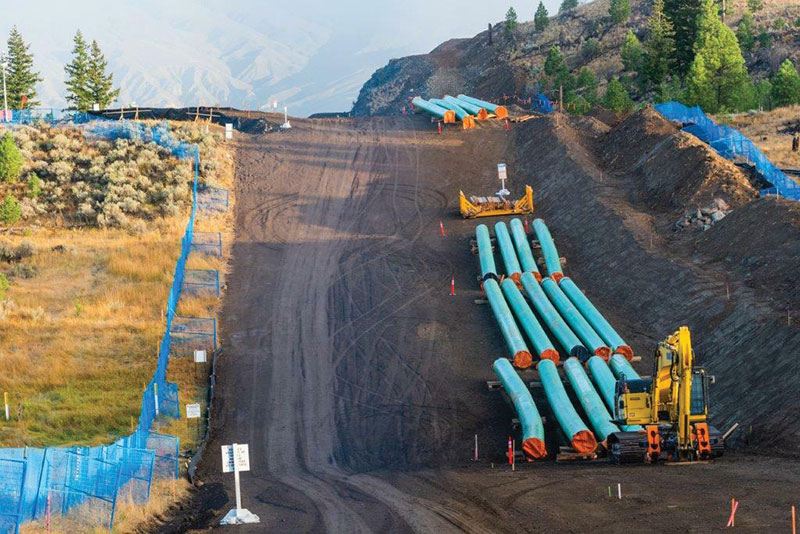US, Canada Natural Gas Output Could Feel Growing Pains In 2023
(Reuters) — U.S. and Canadian natural gas production is expected to hit new records in 2023, but growth may be slow due to weakened demand, pipeline bottlenecks and a lack of new LNG export plants.
Gas demand surged worldwide after Russia cut off Europe's primary supply, and the United States and Canada are expected to feed copious demand for exports in coming years, bolstered by high prices. The two countries produced a record combined 116 billion cubic feet per day (Bcf/d) in 2022.
The United States has become one of Europe's most important sources of gas, providing essential energy security after Moscow's invasion of Ukraine.
Next year's growth could be slower than recent years. Major production fields in both countries are inhibited by a lack of pipelines to move gas to key markets, including export terminals in the U.S. Gulf. Canada is in the midst of building a large terminal to export LNG, but its completion is two years away.
"It’s not production that can’t keep up, it’s just simply infrastructure constraints," said Alan Armstrong, chief executive of Williams Cos, one of the biggest U.S. pipeline companies. "We’re going to go through a period here where production is going to be a little bit constrained."
Much of U.S. and Canadian gas output increases this year came from gas associated with oil production in places like the Permian in West Texas and eastern New Mexico.
Bottlenecks Constrain Output
U.S. gas output is expected to rise to 100.4 Bcf/d in 2023, up 2% from 2022's level, according to U.S. energy data. Canadian gas production is on track to reach a record 18 Bcf/d in 2022 and 19 Bcf/d in 2023, according to energy consultancy Rystad Energy.
Output in the Haynesville, located in Arkansas, Louisiana and Texas, and the Permian has increased more than 20% annually over the past five years and was on track to rise about 10% in 2022, according to federal forecasts.
But continued growth depends on building more pipelines, lest those basins become constrained like Appalachia, the biggest U.S. shale gas region in Pennsylvania, Ohio and West Virginia.
Pipelines are also constrained in Canada due to swift production growth, particularly TC Energy Corp.'s NGTL pipeline system that ships gas around and out of western Canada.
In August, gas prices in Alberta briefly turned negative because of bottlenecks stemming from NGTL maintenance. TC Energy is expanding the system to boost flows.
Growing LNG Export Demand
From 2017 to 2021, U.S. LNG exports rose by an average of 96% annually, but that pace is expected to slow with no new U.S. terminals set to open in 2023.
U.S. LNG exports are expected to reach 10.6 Bcf/d in 2022 and 12.3 Bcf/d in 2023, according to federal estimates. Exports could rise in 2023 once Freeport LNG's plant in Texas returns to service. It has been closed for several months since a fire in June. At least two new U.S. LNG export plants are expected to enter service in 2024.
"Growth in associated gas will cause an oversupply of gas going into next year because we don't see the same growth in demand until new LNG export plants enter service in the 2025-2030 time frame," said Rob Wilson, vice president of analytics at energy research firm East Daley.
If Canadian output rises in anticipation of future shipments from the Shell-led LNG Canada project starting in 2025, it could depress prices, Wood Mackenzie analyst Dulles Wang said.
Analysts expect gas prices at the U.S. Henry Hub benchmark NG-W-HH-SNL in Louisiana to average $5.19 per MMBtu in 2023, down from the current $5.39.
Related News
Related News

- Keystone Oil Pipeline Resumes Operations After Temporary Shutdown
- Biden Administration Buys Oil for Emergency Reserve Above Target Price
- Freeport LNG Plant Runs Near Zero Consumption for Fifth Day
- Enbridge to Invest $500 Million in Pipeline Assets, Including Expansion of 850-Mile Gray Oak Pipeline
- Williams Delays Louisiana Pipeline Project Amid Dispute with Competitor Energy Transfer
- Evacuation Technologies to Reduce Methane Releases During Pigging
- Editor’s Notebook: Nord Stream’s $20 Billion Question
- Enbridge Receives Approval to Begin Service on Louisiana Venice Gas Pipeline Project
- Russian LNG Unfazed By U.S. Sanctions
- Biden Administration Buys Oil for Emergency Reserve Above Target Price





Comments